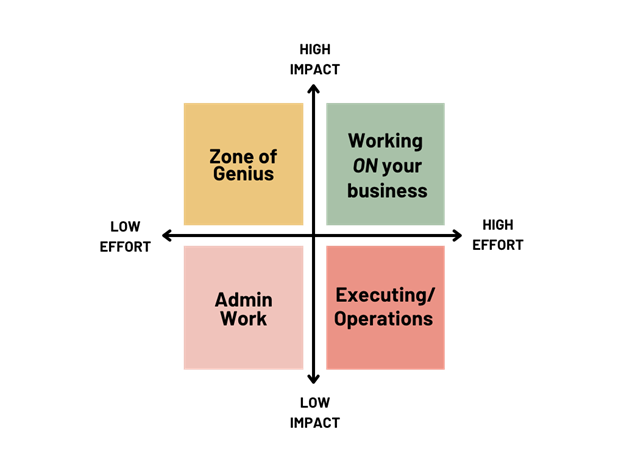Small Business Efficiency: The power of knowing how to spend your time
Do you ever feel like you are doing it ALL and are finding it hard to keep up?
When you are a solopreneur or small business owner with a very small staff, you do all the things in your business. You’re the product maker, the head of marketing, the bookkeeper, the office manager, and so on and so on.
With all of these responsibilities, how do you get things done?
And are they even the “right things?”
Small Business Tips For Work Efficiency
Classifying Your Work
I recently read this blog from Rad Reads that talks about what type of work “moves the needle.”
In it, they classify the different types of work as:
$10 work (busywork like emails)
$100 work (more busywork, but you’ve scaled it with tools)
$1K work (this is where you’re using your unique skills to execute), and
$10K work (this is where you’re developing and advancing your business).
This idea of $10 tasks really got me thinking. The intentions were very similar to my last blog Developing a Business Strategy: What's the difference between working ON your business vs. IN your business? and it leads to 2 questions:
What are you currently spending your time on?
What should you actually spend your time on?
What are you currently spending your time on?
Instead of creating to-do lists or going off of memory, I suggest actually tracking your time for the following 3 reasons:
It helps you identify “hidden tasks” or tasks you forget about, like attending that semi-regular coaching call, or cleaning your studio or workspace, or writing your to-do lists.
It can really help keep you on task and work more efficiently. The simple function of setting a timer for 1 specific task keeps you focused on that task until it is complete. Sometimes we fall into thinking that we are multi-tasking, but multi-tasking is a myth. It’s really just task switching and it is a major drain on productivity.
It’s SUPER helpful in getting clear on how long specific tasks take. No longer do you need to play the guessing game of “I think that will take me x minutes/hours/days to complete”
There are plenty of tools out there that will make this easier for you. For example, I use Toggl Track.
I suggest that you spend at least a month tracking all your work. It may seem tedious, but this will give you very good information concerning how you are currently spending your work time and on what.
Effort & Impact- Knowing what to actually spend your time on
Once you have that information, you can categorize and rank your work based on effort and impact.
Effort = How challenging is it for you to do?
Impact = Will it drive change in your business?
Here’s the axis I use to categorize and rank my work:
After mapping out your work, you’re able to see the items that need adjustment.
What did you notice about how you are spending your time? Are there any trends?
Categorizing your work in this way is a quick way to see if your workload is imbalanced, or if there are gaps in how you are spending your time. For example, maybe you spend a large percentage of time on admin work, and no time on developing your business.
Noticing the trends in how you spend your time can help you adjust your ways of working to align with your desires for your business.
Maybe it will help you see that you need a new process to optimize your time, like batching certain types of work (e.g. social media).
I even had a client that modified their shipping process after they saw how long that process took them.
It can also help you in your decision to hire support for your business. Maybe this categorization exercise helps you see that it’s time that someone else handles the admin tasks so that you have more time to work on the things you are best at (your zone of genius).
Or maybe you hire strategy support (🙋 hi, it’s me!) because you aren’t spending enough time there and aren’t sure where to start.
So now, based on this, how can you know what you should actually spend your time doing?
I’ve created a mini-guide to walk you through my process.
This guide will help you determine what the most impactful work is for YOU and your business.

